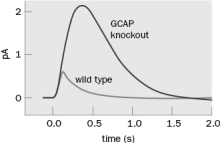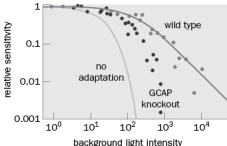Essay
Our visual system has a remarkable dynamic range. When you go to a matinee movie (during the daytime) and walk out of the theater it is difficult to see. After a few minutes your eyes adapt to the new light levels. Some of the molecular mechanisms of light adaptation are known and most involve changes in Ca2+ concentration. (A)
(B)
Figure Q4-13
A. Based on the data from the experiments shown in Figure Q4-13, what is one mechanism of adaptation? Figure Q4-13A shows the dark-adapted response to a flash of light in wild type and GCAP knockout mice. Figure Q4-13B shows the rod response to a flash of light relative to the same flash after dark adaptation.
B. What is the probable molecular mechanism of reduced light adaptation involving GCAP?
Correct Answer:

Verified
Figure Qshows that GCAP is involved in d...View Answer
Unlock this answer now
Get Access to more Verified Answers free of charge
Correct Answer:
Verified
View Answer
Unlock this answer now
Get Access to more Verified Answers free of charge
Q2: When people get older the lens becomes
Q3: You are out in the middle of
Q4: What type of visual information is coded
Q5: Hubel and Wiesel identified simple cells and
Q6: Where does binocular input first occur in
Q8: The visual system is organized into
Q9: What is the receptive field of a
Q10: Rhodopsin is what kind of protein?<br>A) Voltage-dependent
Q11: Match the receptive field to the appropriate
Q12: What would happen if you blocked phosphodiesterase